Eneko Agirre
Lengoia eta Informatikoak saila, Euskal Erriko Universitatea
NLP Evaluation in trouble: On the Need to Measure LLM Data Contamination for each Benchmark
Oct 27, 2023Abstract:In this position paper, we argue that the classical evaluation on Natural Language Processing (NLP) tasks using annotated benchmarks is in trouble. The worst kind of data contamination happens when a Large Language Model (LLM) is trained on the test split of a benchmark, and then evaluated in the same benchmark. The extent of the problem is unknown, as it is not straightforward to measure. Contamination causes an overestimation of the performance of a contaminated model in a target benchmark and associated task with respect to their non-contaminated counterparts. The consequences can be very harmful, with wrong scientific conclusions being published while other correct ones are discarded. This position paper defines different levels of data contamination and argues for a community effort, including the development of automatic and semi-automatic measures to detect when data from a benchmark was exposed to a model, and suggestions for flagging papers with conclusions that are compromised by data contamination.
Automatic Logical Forms improve fidelity in Table-to-Text generation
Oct 26, 2023



Abstract:Table-to-text systems generate natural language statements from structured data like tables. While end-to-end techniques suffer from low factual correctness (fidelity), a previous study reported gains when using manual logical forms (LF) that represent the selected content and the semantics of the target text. Given the manual step, it was not clear whether automatic LFs would be effective, or whether the improvement came from content selection alone. We present TlT which, given a table and a selection of the content, first produces LFs and then the textual statement. We show for the first time that automatic LFs improve quality, with an increase in fidelity of 30 points over a comparable system not using LFs. Our experiments allow to quantify the remaining challenges for high factual correctness, with automatic selection of content coming first, followed by better Logic-to-Text generation and, to a lesser extent, better Table-to-Logic parsing.
Unsupervised Domain Adaption for Neural Information Retrieval
Oct 13, 2023Abstract:Neural information retrieval requires costly annotated data for each target domain to be competitive. Synthetic annotation by query generation using Large Language Models or rule-based string manipulation has been proposed as an alternative, but their relative merits have not been analysed. In this paper, we compare both methods head-to-head using the same neural IR architecture. We focus on the BEIR benchmark, which includes test datasets from several domains with no training data, and explore two scenarios: zero-shot, where the supervised system is trained in a large out-of-domain dataset (MS-MARCO); and unsupervised domain adaptation, where, in addition to MS-MARCO, the system is fine-tuned in synthetic data from the target domain. Our results indicate that Large Language Models outperform rule-based methods in all scenarios by a large margin, and, more importantly, that unsupervised domain adaptation is effective compared to applying a supervised IR system in a zero-shot fashion. In addition we explore several sizes of open Large Language Models to generate synthetic data and find that a medium-sized model suffices. Code and models are publicly available for reproducibility.
GoLLIE: Annotation Guidelines improve Zero-Shot Information-Extraction
Oct 06, 2023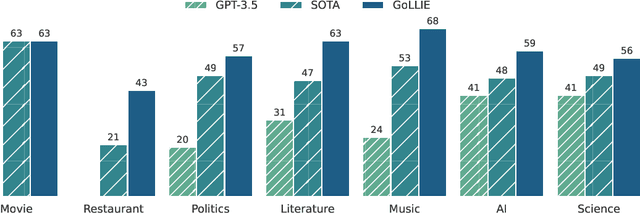
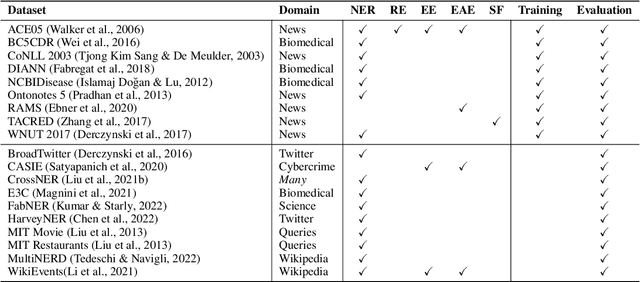
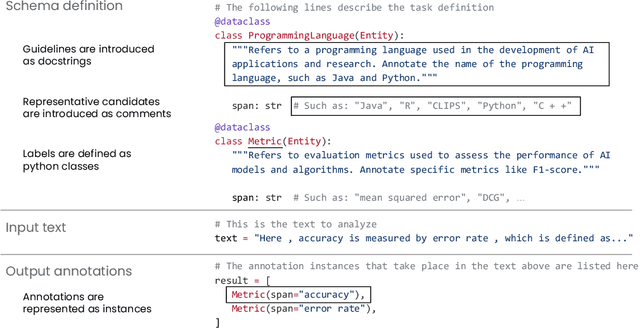
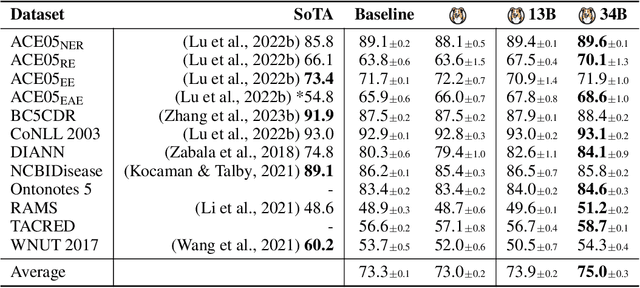
Abstract:Large Language Models (LLMs) combined with instruction tuning have made significant progress when generalizing to unseen tasks. However, they have been less successful in Information Extraction (IE), lagging behind task-specific models. Typically, IE tasks are characterized by complex annotation guidelines which describe the task and give examples to humans. Previous attempts to leverage such information have failed, even with the largest models, as they are not able to follow the guidelines out-of-the-box. In this paper we propose GoLLIE (Guideline-following Large Language Model for IE), a model able to improve zero-shot results on unseen IE tasks by virtue of being fine-tuned to comply with annotation guidelines. Comprehensive evaluation empirically demonstrates that GoLLIE is able to generalize to and follow unseen guidelines, outperforming previous attempts at zero-shot information extraction. The ablation study shows that detailed guidelines is key for good results.
CombLM: Adapting Black-Box Language Models through Small Fine-Tuned Models
May 23, 2023



Abstract:Methods for adapting language models (LMs) to new tasks and domains have traditionally assumed white-box access to the model, and work by modifying its parameters. However, this is incompatible with a recent trend in the field, where the highest quality models are only available as black-boxes through inference APIs. Even when the model weights are available, the computational cost of fine-tuning large LMs can be prohibitive for most practitioners. In this work, we present a lightweight method for adapting large LMs to new domains and tasks, assuming no access to their weights or intermediate activations. Our approach fine-tunes a small white-box LM and combines it with the large black-box LM at the probability level through a small network, learned on a small validation set. We validate our approach by adapting a large LM (OPT-30B) to several domains and a downstream task (machine translation), observing improved performance in all cases, of up to 9%, while using a domain expert 23x smaller.
What do Language Models know about word senses? Zero-Shot WSD with Language Models and Domain Inventories
Feb 07, 2023



Abstract:Language Models are the core for almost any Natural Language Processing system nowadays. One of their particularities is their contextualized representations, a game changer feature when a disambiguation between word senses is necessary. In this paper we aim to explore to what extent language models are capable of discerning among senses at inference time. We performed this analysis by prompting commonly used Languages Models such as BERT or RoBERTa to perform the task of Word Sense Disambiguation (WSD). We leverage the relation between word senses and domains, and cast WSD as a textual entailment problem, where the different hypothesis refer to the domains of the word senses. Our results show that this approach is indeed effective, close to supervised systems.
Lessons learned from the evaluation of Spanish Language Models
Dec 16, 2022Abstract:Given the impact of language models on the field of Natural Language Processing, a number of Spanish encoder-only masked language models (aka BERTs) have been trained and released. These models were developed either within large projects using very large private corpora or by means of smaller scale academic efforts leveraging freely available data. In this paper we present a comprehensive head-to-head comparison of language models for Spanish with the following results: (i) Previously ignored multilingual models from large companies fare better than monolingual models, substantially changing the evaluation landscape of language models in Spanish; (ii) Results across the monolingual models are not conclusive, with supposedly smaller and inferior models performing competitively. Based on these empirical results, we argue for the need of more research to understand the factors underlying them. In this sense, the effect of corpus size, quality and pre-training techniques need to be further investigated to be able to obtain Spanish monolingual models significantly better than the multilingual ones released by large private companies, specially in the face of rapid ongoing progress in the field. The recent activity in the development of language technology for Spanish is to be welcomed, but our results show that building language models remains an open, resource-heavy problem which requires to marry resources (monetary and/or computational) with the best research expertise and practice.
Principled Paraphrase Generation with Parallel Corpora
May 24, 2022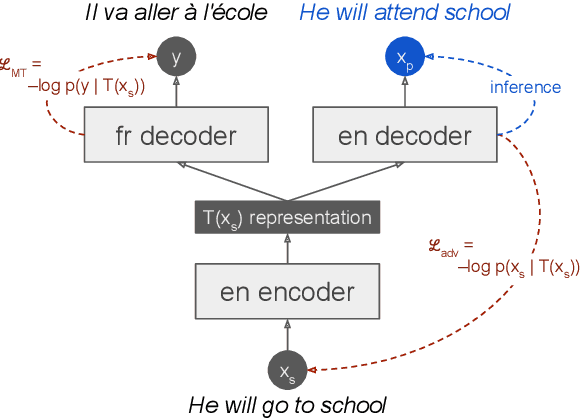
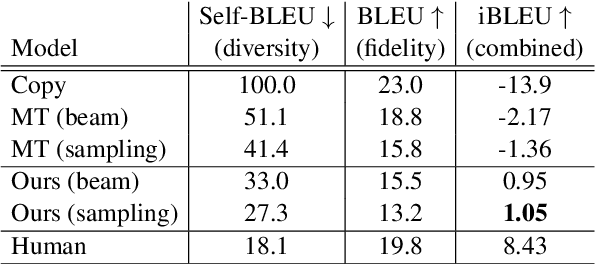

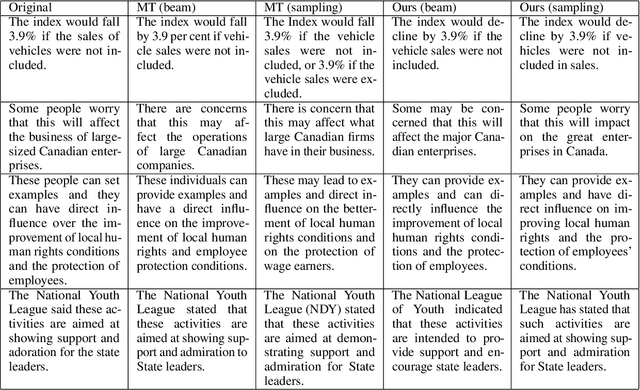
Abstract:Round-trip Machine Translation (MT) is a popular choice for paraphrase generation, which leverages readily available parallel corpora for supervision. In this paper, we formalize the implicit similarity function induced by this approach, and show that it is susceptible to non-paraphrase pairs sharing a single ambiguous translation. Based on these insights, we design an alternative similarity metric that mitigates this issue by requiring the entire translation distribution to match, and implement a relaxation of it through the Information Bottleneck method. Our approach incorporates an adversarial term into MT training in order to learn representations that encode as much information about the reference translation as possible, while keeping as little information about the input as possible. Paraphrases can be generated by decoding back to the source from this representation, without having to generate pivot translations. In addition to being more principled and efficient than round-trip MT, our approach offers an adjustable parameter to control the fidelity-diversity trade-off, and obtains better results in our experiments.
PoeLM: A Meter- and Rhyme-Controllable Language Model for Unsupervised Poetry Generation
May 24, 2022
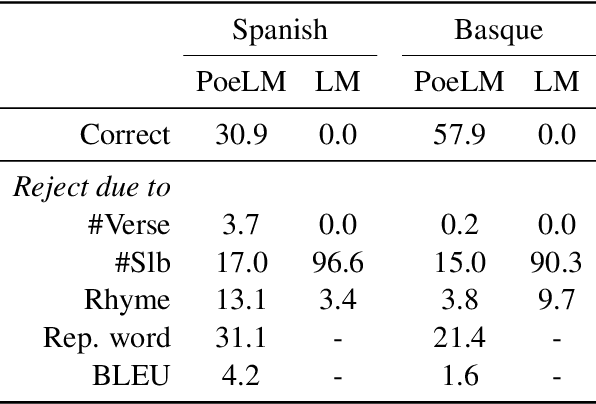
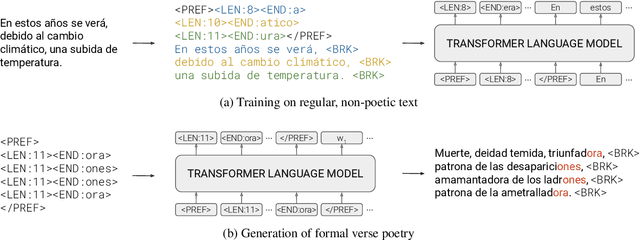
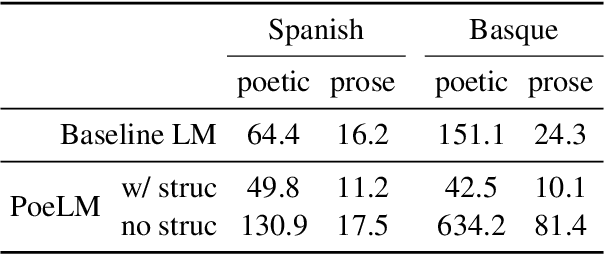
Abstract:Formal verse poetry imposes strict constraints on the meter and rhyme scheme of poems. Most prior work on generating this type of poetry uses existing poems for supervision, which are difficult to obtain for most languages and poetic forms. In this work, we propose an unsupervised approach to generate poems following any given meter and rhyme scheme, without requiring any poetic text for training. Our method works by splitting a regular, non-poetic corpus into phrases, prepending control codes that describe the length and end rhyme of each phrase, and training a transformer language model in the augmented corpus. During inference, we build control codes for the desired meter and rhyme scheme, and condition our language model on them to generate formal verse poetry. Experiments in Spanish and Basque show that our approach is able to generate valid poems, which are often comparable in quality to those written by humans.
Textual Entailment for Event Argument Extraction: Zero- and Few-Shot with Multi-Source Learning
May 03, 2022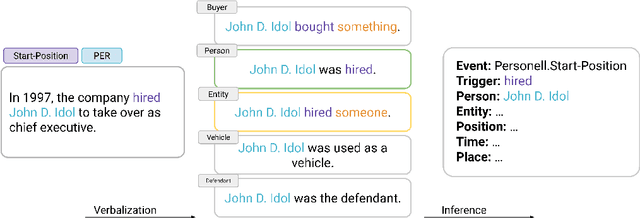
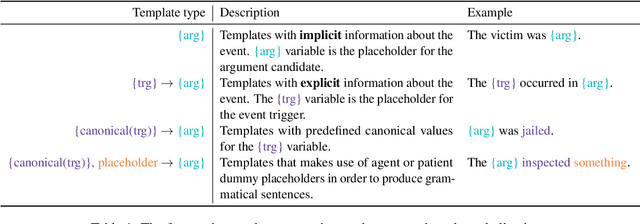
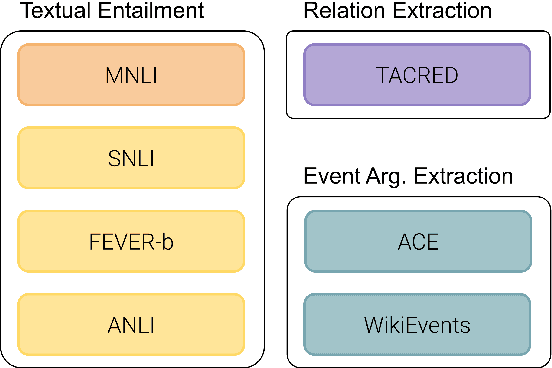
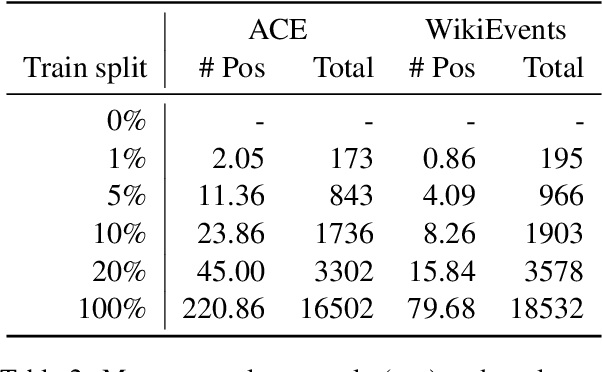
Abstract:Recent work has shown that NLP tasks such as Relation Extraction (RE) can be recasted as Textual Entailment tasks using verbalizations, with strong performance in zero-shot and few-shot settings thanks to pre-trained entailment models. The fact that relations in current RE datasets are easily verbalized casts doubts on whether entailment would be effective in more complex tasks. In this work we show that entailment is also effective in Event Argument Extraction (EAE), reducing the need of manual annotation to 50% and 20% in ACE and WikiEvents respectively, while achieving the same performance as with full training. More importantly, we show that recasting EAE as entailment alleviates the dependency on schemas, which has been a road-block for transferring annotations between domains. Thanks to the entailment, the multi-source transfer between ACE and WikiEvents further reduces annotation down to 10% and 5% (respectively) of the full training without transfer. Our analysis shows that the key to good results is the use of several entailment datasets to pre-train the entailment model. Similar to previous approaches, our method requires a small amount of effort for manual verbalization: only less than 15 minutes per event argument type is needed, and comparable results can be achieved with users with different level of expertise.
 Add to Chrome
Add to Chrome Add to Firefox
Add to Firefox Add to Edge
Add to Edge